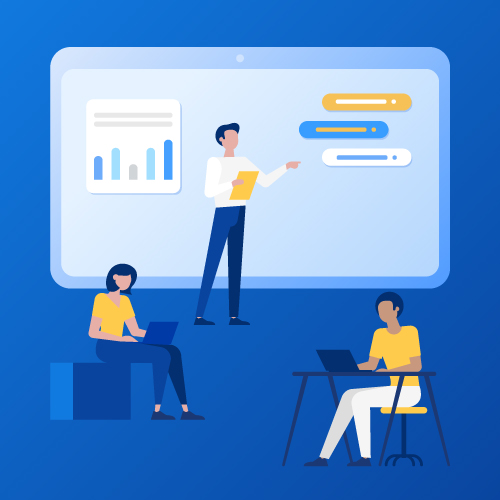The workforce of the majority of organizations is evolving in one or the other ways because of numerous factors like competitive markets, multigenerational workforce, new complexities of businesses, digital evolutions, employee diversity, and much more reasons. The new L&D strategy set, talents, efficiencies, and creativities are snowballing day by day, making the entire professional universe even more competitive. Due to the major shift from a knowledge-based economy to a digital economy, now a vibrant workforce is a mandate to sustain the business.
Under such circumstances, it’s obligatory to remain and keep your teams updated with the required skills, knowledge, and talent. Recent research has proven that investment in this sector is one of the significant expenses management is undertaking to create and ensure a coordinated strategy to meet the company goals in the long run.
The training and Learning process is defined in this diagram as per their contribution in a real sense to the employees.
Training is the process of equipping employees with the knowledge and skill required to perform a particular task. Learning and development is the process of absorbing that information in order to increase skills and abilities and make use of it in a variety of contexts. Constant learning results in the overall development of the resource, which results in giving the company a high-performing employee.
Components to be considered while carving the L&D strategy process in an organization. For most prominent responsibility of L&D is to have a flawless process of attracting and hiring the right people and retaining them for longer.
- Attracting and Hiring the right talent.
- Training them as per the organizational needs.
- Motivating and engaging them.
- Building employer brand in their mind.
- Emphasizing and creating a value-based culture.
- Developing their capabilities.
L&D Objectives:
It’s important to understand and define the real objective behind this entire process of L&D. The focus is on shaping the desired culture, fostering new ways of thinking, developing new behaviors, and driving strategic opportunities.
Main Objectives
- Drive Organizational Growth– Moving closer to the end goal
- Enhanced Resource Capabilities– Closing the skill gap, resulting in better performance
- Engaged, Involved and Thriving Workforce– Resulting in increased retention
- Better Learning Culture– which triggers intellectual stimulation encouraging creativity and innovation
- Individual Growth– which brings better job satisfaction
L&D Framework or Strategy:
Capability assessment and Training Needs Identification
Every organization has different business priorities and demands for various skill sets. They first need to analyze whether their employee is skilled enough to take the role and deliver the expected result. Hence it’s vital they first have to deep dive to find out the real need and gap in training among its employees.
Understanding the real gap in skills, behavior, and attitude is the key point to be considered before implementing an L&D strategy. At Inferenz, this process is well defined, discussed, and revised as and when required for better clarity about the employee’s real state. Most of good and well-organized companies have a deliberate and systematic approach to capability assessment followed by training need identification.
Training Need Analysis & Evaluation
After finding those gaps, the next thing to be done is to study and understand the extent of that gap and how this gap can be fixed or met. Training needs analysis to seal that gap effectively, whereas training needs evaluation is simply understanding whether training should be conducted or not for that particular gap. Or in other words, the gap can be fixed by some other means but not training.
Designing the precise Program/ Curriculum of training
Once the needs are understood, the approach to meet the needs is planned, and training programs are selected and designed effectively to make sure the impact is deep and long-lasting. At Inferenz, the L&D strategy teams create the content as per the need of the employees, team, or the project they are involved in. The designing of content depends on the majority of the intent, type of crowd, understanding levels, and learning styles which certainly vary from employee to employee, and the projects they are involved in.
Many organizations now provide digital training, but research says there is no substitute to in per-personal classroom training. The main objective remains the same the learning must be utilized in their actual job.
Execution & Implementation
At Inferenz, training is planned, scheduled, and managed flawlessly so that there is a clear, better, and continuous understanding of the subject matter with the required handouts and takeaways for reference.
Evaluation of the impact
The impact of the training provided needs to be evaluated to understand its effectiveness. They are generally measured by Key Performance Indicators KPIs. There is no simple way to accurately find out the impact of such training. Many organizations have the traditional methods of evaluating that through learning program completion scores etc.
Yet much other organization like Inferenz believes in a real-time attitudinal change or Feedback from the participant after the session and reporting leader to gauge the efficiency and impact of the training conducted.
Incorporation of L&D interventions into HR Processes
Just like the L&D process must be aligned with the business of the organization, it must be aligned with the HR Processes as well. Human resource is an integral part of any organizational system; they are involved in scrutinizing profiles, interviewing and selection, appraisal, and succession planning of the workforce. To understand this at Inferenz, L&D gets merged with the HR system to evaluate and train the candidates accordingly. At the same time, with the training evaluation, the HR team has a fair understanding of the actual growth of the employee, which can assist them in a genuine appraisal.
An organization’s ability to learn and translate that learning into action rapidly is the ultimate competitive advantage. — Jack Welch, former General Electric CEO












